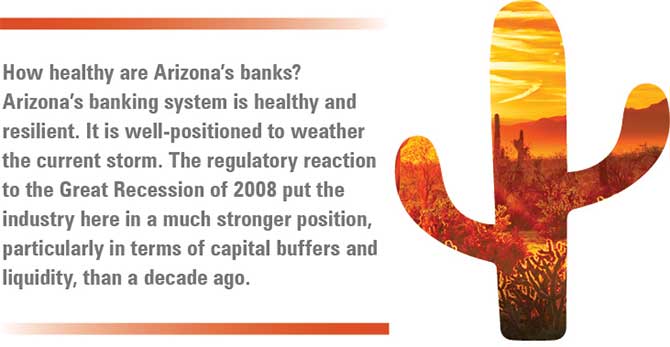By Dale Brown — Research Director, Phoenix Business Journal
First appeared in the Phoenix Business Journal on December 10, 2020
The coronavirus pandemic has had ripple effects across all sectors in 2020, and the banking and financial services business has had its share of bumps and bruises.
Across the Valley, many brick-and-mortar bank branches closed amid the COVID-19 stay-at-home orders, and some have been shuttered permanently as a result. Still, the sector has also been buoyed by the continued surge in real estate activity in the Valley. At the same time, the SBA-administered the Paycheck Protection Program, despite some instances of misuse, kept bankers extremely busy.
Meanwhile, some out-of-state bank brands started bulking up operations in the Valley, and one of the biggest M&A deals of the year was announced in November when Pittsburgh-based PNC Financial Services agreed to buy the U.S. banking arm of European financial giant BBVA.
We caught up with Paul Hickman, president and CEO of the Arizona Bankers Association, to weigh in on how the industry is doing.
Has the Valley’s residential buying boom caused area banks to tighten or change their lending criteria?
Not in any fundamental sense. The housing-induced real estate crash of 2008-2009 resulted in the loss of many financial institutions and the decision to exit the residential mortgage lending line of business by many others. The remaining residential mortgage lending industry already had much tighter underwriting standards than the industry-at-large. The regulations put into place per the Dodd-Frank Act of 2010 leave little latitude for banks to loosen residential mortgage lending criteria now.
How has the pandemic impacted mortgage lending specifically?
It has significantly increased the volume of mortgage lending, particularly in the Phoenix MSA. It has also created a demand-driven increase in price — somewhat abetted by shortages of lots and new building materials.
Where do you see interest rates heading over the next year if the pandemic continues?
It’s important first to note what the pandemic has done to interest rates already. The effective federal funds rate has cratered nearly 150 basis points since February. In November, the Fed announced they would leave rates where they are for the time being. And where they are is essentially at zero. It’s also worth noting that interest rates are currently tied almost exclusively to the pandemic’s economic fallout. It is entirely fair to assume that those rates will begin to rise once the vaccine starts to ameliorate current economic indicators. Personally, I don’t see that happening until the first quarter of 2022 at the earliest.
How healthy are Arizona’s banks?
Arizona’s banking system is healthy and resilient. It is well-positioned to weather the current storm. The regulatory reaction to the Great Recession of 2008 put the industry here in a much stronger position, particularly in terms of capital buffers and liquidity, than a decade ago. The $64,000 questions for the banking industry now are how long will the pandemic weigh down the broader economy? And how much more help will the federal government provide in what’s left of the current administration and into the new administration early next year? The answer to the first question depends on how fast the vaccines can penetrate our population, which turns on how many people will get immunized and how soon. We hope that there will be another round of stimulus in the near-term to bridge us until we have a significant portion of our population vaccinated and, therefore, back at work and play.

Does Arizona have the right mix of large, national scale banks and community banks with a better knowledge of the local scene?
Is there room for more local banks, and how have recent deals impacted that? Yes. While it is not the largest banking sector of states of our size, it is diverse, measured by asset size. All three of the “money center” banks larger than $1 trillion operate here. We have a significant number of regionals and super-regionals. And we are holding our own with community banks, Community Development Financial Institutions and credit unions with assets below $1 billion. There is plenty of room for more local banks. We have two community bank de novos working their way toward opening sometime next year (Scottsdale Community Bank and Gainey Business Bank).
That said, we are not exempt from the accelerating M&A trend sweeping the country for the last several years. This year we saw Arizona Bank & Trust take over the assets and liabilities of Johnson Bank, and the First Citizens merger with CIT impacted us. (Keeping in mind that CIT acquired Mutual of Omaha Bank last year, which had a significant footprint here.) It would appear that until the de novos come online, we will go into 2021 with two fewer banks than we started the year, which will take us from 65 to 63 banks stretching from Phoenix to Flagstaff, Tubac to Tuba City — and all points between.
Dale Brown — Research Director, Phoenix Business Journal
First appeared in the Phoenix Business Journal on December 10, 2020
This story appears in Issue 4 2020 of The Arizona Banker Magazine.









